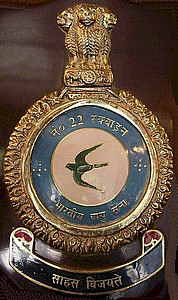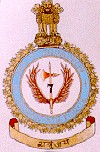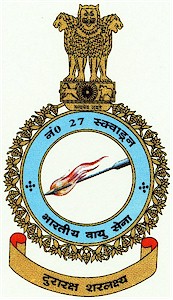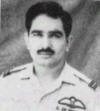
The Indian Air Force (IAF) is the air arm of the Indian Armed Forces. Its primary mission is to secure Indian airspace and to conduct aerial warfare during armed conflicts. It was officially established on 8 October 1932 as an auxiliary air force of the British Empire which honoured India's aviation service during World War II with the prefix Royal. After India gained independence from United Kingdom in 1947, the name Royal Indian Air Force was kept and served in the name of the Dominion of India. With the transition to a republic in 1950, the prefix Royal was removed.

Pakistan Air Force Base, Nur Khan is an active Pakistan Air Force airbase located in Chaklala, Rawalpindi, Punjab province, Pakistan. The former Benazir Bhutto International Airport forms part of this airbase. Fazaia Intermediate College, Nur Khan is also located in the base.

No. 22 Squadron (Swifts) was a CAS unit based out of Hasimara AFS. Along with No. 222 Squadron IAF Tiger Sharks, No. 22 Squadron forms a part of the 16 Wing of the IAF. The squadron operated MiG-27 till December 2017 and the squadron number-plated since then.

No. 7 Squadron, Indian Air Force operates as a Special Munitions Delivery and air superiority unit. Based at Gwalior AFB, No.7 Squadron forms a part of 40 Wing AF, Central Air Command.
The No.3 Squadron (Cobras) of the Indian Air Force (IAF) operates as a Close Air Support (CAS) and reconnaissance unit. Currently based at NAL Air Force Station, No. 3 Sqn falls under the Western Air Command, forms the 46 wing of the IAF.
The Ambala Air Force Station is an Air Force base situated north of the urban Ambala Cantt area in Haryana, India. The Ambala Air Force Station is the home to the first batch of advance multirole fighter jet Dassault Rafales that have been inducted to Indian Air Force.

During the Indo-Pakistani war of 1965, the Indian and Pakistani Air Forces engaged in large-scale aerial combat for the first time. In the air war, which took place in September, both air forces conducted thousands of defensive and offensive sorties over Indian and Pakistani airspace. Both India and Pakistan claimed victory in the air war; Pakistan claimed to have destroyed 104 Indian aircraft and lost 19, and India claimed to have destroyed 73 Pakistani aircraft and lost 35 of its own. The air war ended in a stalemate.
Flight Lieutenant Alfred Tyrone Cooke VrC is an Indian pilot who was decorated for his role in the Indo-Pakistani War of 1965. He was honoured with the Vir Chakra in September 1965. He received the award for shooting down a Sabre jet and severely damaging another, whilst flying a Hawker Hunter, whilst they were under anti-aircraft fire. It has been said that, "Flt Lt Alfred Tyrone Cooke is the only pilot in the Indian Air Force, who could claim to have engaged multiple enemy aircraft in the air and got the better of them."
No. 6 Squadron (Dragons) is a fighter squadron and is equipped with Jaguar IM/IS and based at Jamnagar Air Force Station.
The Central Air Command is one of the five operational commands of the Indian Air Force. It is currently headquartered in Prayagraj in Uttar Pradesh. It was formed on 19 March 1962, at Rani Kuthee, Calcutta.

Air Force Station Hindon is an Indian Air Force base under the Western Air Command (WAC). It is the biggest and largest air base in Asia. Its area measured 14 km rounded and 55 square kilometres (21 sq mi). This base celebrates Air Force Day on 8 October. It is located near Loni Ghaziabad in the state of Uttar Pradesh in the National Capital Region on the outskirts of Delhi, close to the Hindon River. Starting 2006, the annual Air Force Day Parade venue was shifted from Palam Airport to Hindon. There is one runway, aligned east–west (09-27), of 9,000 feet (2,700 m) length x 150 feet (46 m) width. The military airbase serves as the home of the IAF C-17 Globemaster and the IAF C-130J Super Hercules, the backbone of Strategic Heavy Air Lift division of the Indian Air Force. The Airports Authority of India (AAI) operates a civil enclave at Hindon as part of the government's Regional Connectivity Scheme (RCS).

No. 16 Squadron Indian Air Force , is a counter-air and interdiction unit, operating out of the Indian Air Force station in Gorakhpur.

No. 27 Squadron IAF is a Ground-Attack and Close Air Support squadron of the Indian Air Force, operating from Gorakhpur AFS, under Central Air Command.
No. 26 Squadron IAF (Warriors) is a Ground Attack and Close Air Support unit of the Indian Air Force, operating from Pathankot Air Force Station under India's Western Air Command. The squadron was number plated on an unspecified date.
Squadron Leader Mandepanda Appachu Ganapathy was a fighter pilot and officer of the Indian Air Force, known for his involvement in the Aerial Battle of Boyra during the Indo-Pakistani War of 1971. He was awarded the Vir Chakra for shooting down a PAF Sabre in the above-mentioned aerial battle

No. 45 Squadron Indian Air Force is a Fighter Squadron internally based at Sulur AFS, Tamil Nadu. The squadron operates the indigenous HAL Tejas fighter from 1 July 2016. The squadron was initially based at Bangalore, Karnataka and later shifted to its main base in Sulur from 1 June 2018.

The No. 14 Squadron, nicknamed Tail Choppers, is an air superiority squadron of the Pakistan Air Force's Central Air Command. It is one of PAF's most decorated squadrons which earned its nickname after a daring strike mission on the Kalaikunda Air Force Station during the 1965 War. Currently, the Squadron is deployed at PAF Base Rafiqui and operates the PAC JF-17 Thunder multirole aircraft.
The No. 25 Squadron, nicknamed Eagles, is a tactical attack squadron from the No. 34 Wing of the Pakistan Air Force's Central Air Command. It is currently deployed at Rafiqui Airbase and operates ROSE upgraded Dassault Mirage-5EF aircraft.

Wing Commander Amar Jit Singh Sandhu VrC, VM was an Indian Air Force officer and fighter pilot. He was awarded the Vir Chakra and the Vayusena Medals. He is credited with shooting down a Pakistan Air Force North American F-86 Sabre in the Indo-Pakistani War of 1965.

Squadron Leader Ghani Akbar SJ ,is a retired Pakistani fighter pilot and former officer in the Pakistan Air Force. He is best known for taking part in the devastating blitzkrieg on the Pathankot airbase in India during the 1965 Indo-Pakistani War, in which he doubled back and initiated a second attack on the airbase against the orders of his commanding officer Sajad Haider. Additionally, his formation destroyed 13 Indian aircraft including nine MiG-21s.












